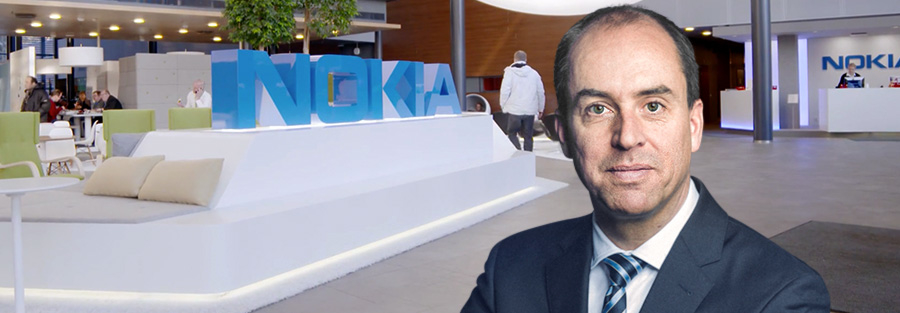Johannes Giloth, Senior Vice President, Global Operations & Chief Procurement Officer, Nokia
SCN: Last year, Gartner described Nokia’s return to its annual Top 25 ranking as “triumphant.” How has the supply chain organization facilitated Nokia’s extraordinary turnaround?
JG: Well, clearly the past five or six years have been a long and challenging journey for Nokia. Though not a specific goal for us, I think making it back onto the Gartner list demonstrates the path forward that we have achieved. Nokia’s supply chain management team’s focus has been on building an integrated, demand-driven approach to agility, anchored in collaborative, value-based partnerships. A range of process optimization tools and strategies has facilitated our progress, but I think the core of our revitalization is tied to the incorporation of Gartner’s bimodal concept throughout our operations. Mode 1, in Gartner-speak, is about the standard implementation of continuous improvement efforts like Kaizen and Six Sigma to achieve maybe 10 percent improvement a year. But that is the bread and butter of a good supply chain. These are the kinds of things you do to be successful for the next two years. To really master the future, you need to have that Mode 2 approach. This is where things get disruptive. This is where you look for 10X improvement vs. 10 percent. It is out of the box, breaking rules, really greenfield. This is where the real innovation comes from; incubating ideas and the masterpiece is taking that great, disruptive idea and then scaling it. So, here we focus on elevating our people to be real entrepreneurs rather than simply being an execution engine.
“The core of our revitalization is tied to the incorporation of Gartner’s bimodal concept throughout our operations.”
SCN: How do you cultivate Mode 2 thinking throughout your extended global team?

JG: It is not really something you can learn from a book or workshop. It is an attitude and mindset. I think it is easy to kill that attitude by putting people in the wrong dimension where that creativity is not appreciated. But, if you really want to foster Mode 2 thinking and achieve Mode 2 results, you need to give people air to breath. To promote a startup mentality within the operations organization we have established a team focusing on Innovation Partnership and Venture Management. The group acts as a venture capital resource that is willing to take risks and focuses on celebrating successes, rather than rebuking failure. This team provides seed money to internal teams who present unique ideas for a new product/service. They also scout externally to bring in innovation ideas to Nokia Business Groups. The most important part of this program, I think, is that we free people from their day-to-day jobs to incubate these ideas. You cannot do seven hours of order management and then turn around and be innovative. That’s just not realistic.
SCN: How challenging is it to attract Mode 2 thinkers into an operations/supply chain environment?
JG: In order to attract talent both inside and outside the company, you need to make sure the supply chain organization is positioned within the company as a value adding business function, not just a support function. I think it is also important to be very visible in the industry so people understand that Nokia supply chain is a leader in our space. That is why we are so actively engaged in various professional conferences and meetings, not only supply chain and procurement related, but also Innovation forums around new technology trends.
With growing competition for supply chain talent, it is also critical to start outreach early through collaboration with Universities. We have a trainee program, where we bring in people who are in the early stage of their career, and we offer them a kind of sneak preview into a career in supply chain.
Then to retain talent, we are also doing a lot of internal professional development. We have created our own “Operations University” for global operations where we have clearly defined career paths in the different professions and offer training to our people to teach the core competence in operations/supply chain they need to pursue that path.
“In order to attract talent both inside and outside the company, you need to make sure the supply chain organization is positioned as a value adding business function.”
SCN: Can you give us an example of how “Mode 2” thinking has enabled Nokia to innovate more?
JG: Absolutely, it’s a bit of a long story, but worth it to illustrate the unique value. One of the pieces of hardware that we produce requires precise tuning to hit the right frequency, and the tuning process was a consistent source of bottleneck for production. Historically, the tuning was performed by a technician literally manually adjusting up to 100 different screws. The process could easily take up to 100 minutes. There was no repeatable IP, just the experience of that one individual.

We felt there had to be a better way, but physicists, technical specialists and even our competitors around the world told us there was no way to automate the process. But, in true Mode 2 fashion, we put together a team to work with researchers at the University of Oulu in Finland. It took a full year to develop a solution, but now we have this algorithm that has enabled us to reduce tuning time to five minutes. Not only are we enjoying greater productivity and flexibility from this new process, but we also gain a lot of data, which creates a feedback loop that enables us to backwards influence the hardware design.
A Mode 1 organization would maybe have given the technician a better screwdriver, but that is not helping the underlying principle problem. It took a Mode 2 approach to truly disrupt this process.
SCN: How are you extending this Mode 2 approach with Nokia’s ecosystem partners?
JG: At Nokia, we believe that the IoT and related analytics are going to play an important role in our company growth. We also understand that no single company has all the skills needed to build future technologies and solutions. We recently launched a beta version of a new Open Ecosystem Network, a co-creation environment designed to change the way we collaborate with our suppliers and partners. This video probably tells the story better than I could:
Nokia has also teamed up with a number of Finnish organizations, including Tekes, CGI, Finpro, VTT Technical Research Centre of Finland Ltd and the Technology Industries of Finland to build a new operation model, called D.Day, that will accelerate global ecosystem collaboration among manufacturing industry players and drive the adaptation of emerging IoT technologies and digitalization.
SCN: Supply chain organizations are increasingly being tasked with supporting greater customer engagement, but few have the opportunity to interface directly with customers. How can you be confident that you understand the customers’ true wants and needs?
JG: You are right; in many organizations supply chain is still seen as a back-end function. We have changed that at Nokia. You cannot steer operations proactively if you are operating based on information that may be a couple of months old and filtered through several different layers of the organization before it gets to you. We interface directly with customers, that is exactly the secret. When we talk about integrated supply chain, it starts at the customer and in our case – it is a customer team. My people are located in more than 150 sites across the globe. Why? Because this enables them to co-locate with our sales people so they know what customers want and feel the same pressure to respond. It’s a one-team approach, and it means we are involved in decisions at a much earlier stage. This is what we call a customer-centric supply chain.

Digitization has also played a pivotal role in expanding supply chain’s reach toward the customers. Even through the more extended tiers of the supply chain, digitization is generating real-time, high complexity, cloud-based data. We have developed integrated demand planning and execution processes and software that allows us to collect feedback very effectively and we have installed a supplier collaborative planning tool that enables us to model complex international supply chains through third tier suppliers. More importantly, we have brought the topic of demand planning to board level. Some decisions can only be made when R&D, sales and supply chain colleagues sit together, which we do on a regular basis for executive S&OP planning.
“My people are located in more than 150 sites across the globe. Why? Because this enables them to co-locate with our sales people so they know what customers want.”
SCN: Tell us about Nokia’s concept of the conscious factory and supply network.
JG: It boils down to what core competencies do you need to run a successful operation and in the past, there was the opinion that you can outsource supply chain and distribution and manufacturing because there were others out there that could do it better for you. We think that is fundamentally wrong. We believe that you do not necessarily need to own the factory or run your own warehouse, but you do need to be the owner of the information and the knowledge of how to run that, and when it comes to second or third tier suppliers you need to understand how the industry is connected together. So, that is our vision of a conscious factory and supply network. An end-to-end ecosystem needs to have end-to-end understanding and deep knowledge. In my view, this is a knowledge play rather than a headcount play.
